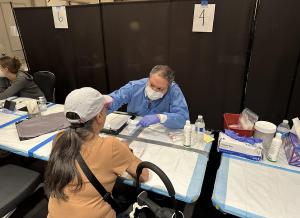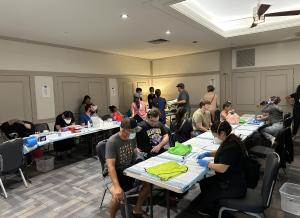Maui residents face health decline, access struggles after wildfires in new UH report
University of Hawaiʻi at MānoaNearly half of the Maui residents affected by the fires experienced a decline in health compared to a year ago, and they continue to face difficulties accessing medical care and medications. These are just two of the findings from the most comprehensive cohort study dedicated to understanding and mitigating the impacts of the Maui wildfires.
Researchers from the University of Hawaiʻi at Mānoa Maui Wildfire Exposure Study (MauiWES) released their first comprehensive report based on surveys and tests collected directly from Maui residents. The results are based on a sample collected mostly in February 2024, and consisted of 679 participants, two-thirds of whom resided in Lahaina at the time of the fires. The other participants either worked in Lahaina, or resided or worked in fire-affected areas in Kula.
Key findings:
- Access to medical care, medications and health insurance disparities: More than four in ten people reported difficulties accessing medical care and medications, compared to about one in ten before the fires. Significant disparities in health insurance coverage were also found, with more than 13% of participants lacking insurance. Notably, nearly 38% of Hispanic respondents reported having no insurance coverage.
- Health outcomes: Nearly half of the participants (46%) reported a decline in health compared to one year ago.
- Physical health: Exposure to smoke, ash, and debris is strongly associated with worse physical health outcomes and reported symptoms. Based on tests conducted in February 2024, approximately 74% of participants face a heightened risk of cardiovascular disease due to elevated or prehypertension levels. Kidney function may be compromised in 8–20% of participants, and up to 60% may suffer from poor respiratory health.
- Mental health: The survey found a notable increase in depression compared to before the fires, with more than half showing symptoms, significantly higher than state and local averages. About 30% of participants reported symptoms of moderate or severe anxiety. Elevated levels of low self- esteem (35%) and suicidal thoughts (4.4%) highlight severe mental health challenges for survivors.
- Community resiliency: MauiWES participants trust and depend on community organizations more than FEMA or local government in the aftermath of the wildfires, underscoring the vital role of grassroots groups in Hawaiʻi’s disaster response.
- Residential impact: Only 34% of participants report living in pre-wildfire (their original) homes, while 56% are in temporary housing, and 10% have settled into new permanent residences.
- Employment and income: The wildfires caused almost half of the participants to lose their jobs; however, 80% have since secured employment, leaving 20% still unemployed at the time of the survey. Additionally, 74% have experienced a reduction in household income.
- Food security: 47% of households report experiencing low food security, which is higher than previous rates observed locally and statewide.
Researchers’ recommendations:
- Medical care and accessibility: Focus on expanding access to healthcare and insurance coverage for individuals affected by the wildfires, particularly in light of urgent health needs in pulmonary, cardiovascular, and behavioral health.
- Housing stability: Ensure stable, long-term housing solutions for displaced individuals through policies supporting housing supply, financial aid, and access to affordable options.
- Environmental safety: Reduce post-wildfire environmental hazards by cleaning up affected areas, monitoring air and water quality during clean-up, and educating residents about protective measures.
- Community support: Strengthen community networks and engage local organizations to provide culturally sensitive support and enhance resilience.
- Additional support: Develop strategies for targeted support for the most vulnerable individuals, including low-income households, food insecure households, immigrants, people with pre-existing physical and mental health conditions, and people with disabilities, in terms of healthcare access and socioeconomic needs.
“The findings of this study clearly highlight the urgent need for continued support from stakeholders and funders, and better utilize the power of community to reach minority populations,” Ruben Juarez and Alika Maunakea said. “Maui is still in the process of healing, and your support is crucial. While other issues like housing are at the forefront, it is equally important to prioritize health to prevent further disparities, especially among our underserved and minority communities. By addressing these health issues alongside other critical needs, we can work towards a more equitable and resilient recovery.”
Publicly available interactive dashboard
The research team has launched the MauiWES interactive dashboard, which contains all available data. All health and social impact metrics can be broken down by age, race and income groups.
Ongoing research
Over at least the next 10 years, the study aims to document the acute and chronic health impacts and social conditions caused by the Maui wildfires.
The study is led by UH Mānoa Professors Ruben Juarez, UHERO-HMSA Distinguished Professor of Health Economics in the UH Mānoa College of Social Sciences, and Alika Maunakea of the Department of Anatomy, Biochemistry and Physiology at the UH Mānoa John A. Burns School of Medicine (JABSOM).
The initiative is a partnership with community-based organizations including the Maui Medic Healers Hui, Roots Reborn, Tagnawa for Maui, and supported by seed funding from the Hawaiʻi Community Foundation Maui Strong Fund and Kaiser Permanente. Additional funding was recently passed through a bill in the state legislature and is waiting for the governor’s signature. This public impact research project is the result of an ongoing partnership between UHERO and JABSOM.
For more information, see this UHERO Focus video.



